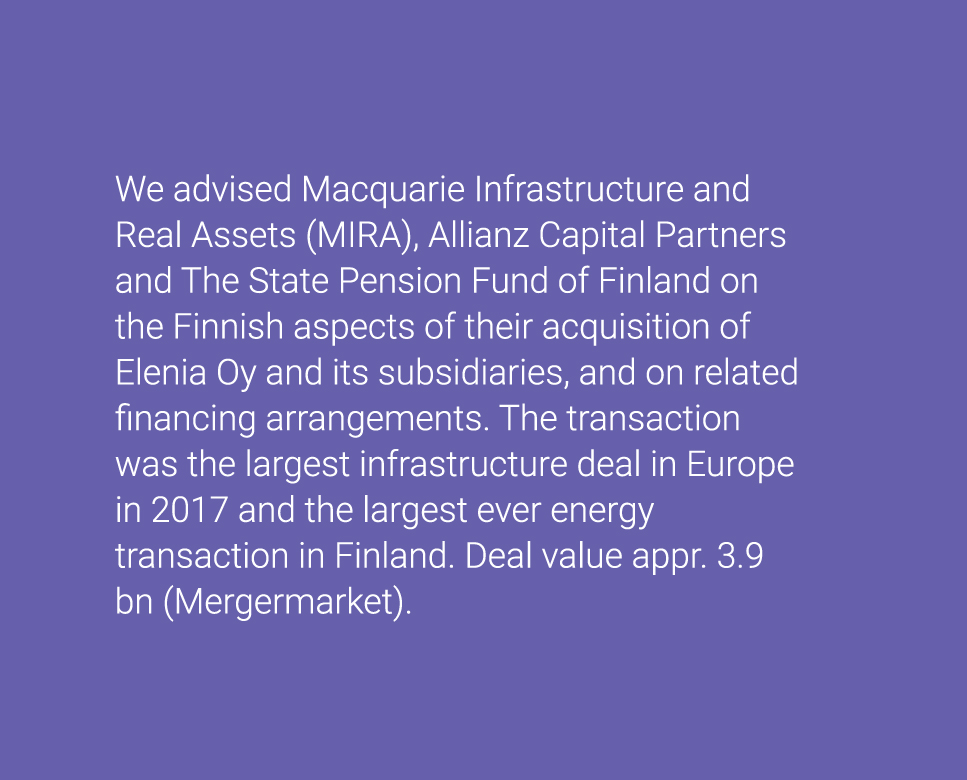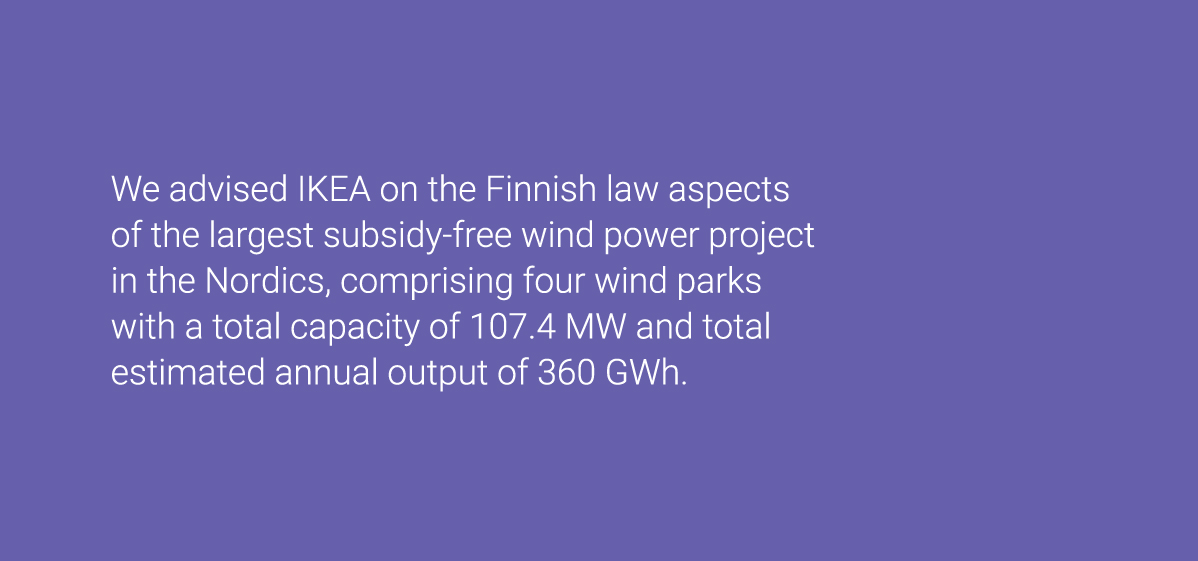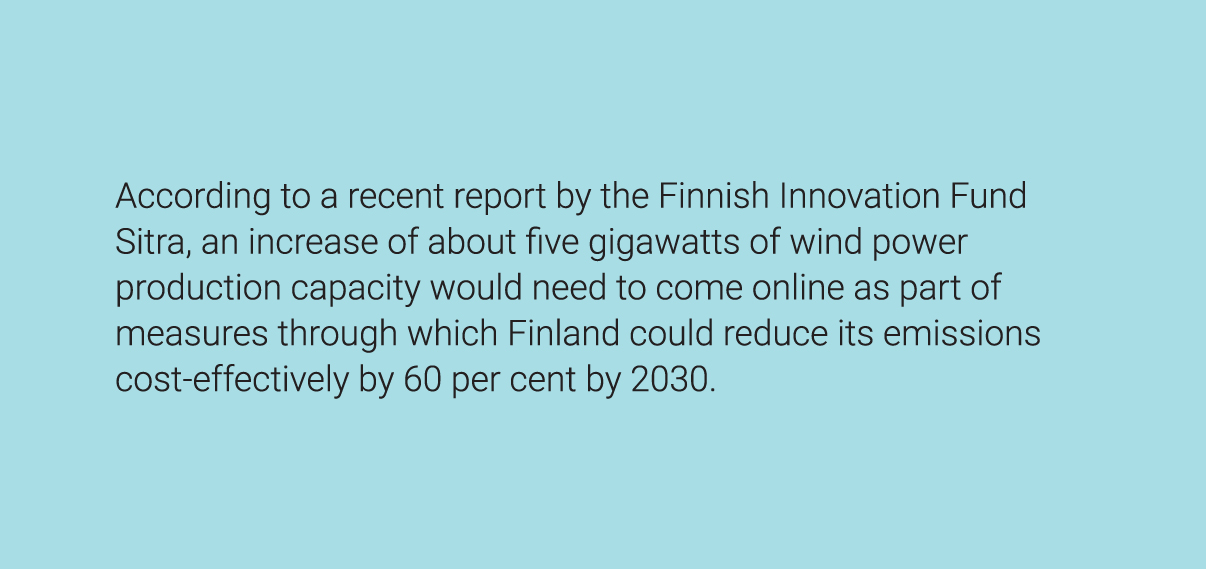Further consolidation and interesting diversified opportunities in the horizon
Recent years have witnessed a strong interest by industrial players and financial sponsors in the energy sector in Finland and the appetite is predicted to remain strong in the coming years. The stability of regulatory regimes, policies aimed at driving the energy system towards carbon neutrality, ensuring security of supply and increasing competition, as well as increasing cost-effectiveness of renewable energy production technologies are all expected to encourage further consolidation and other transaction activity and create investment opportunities both for incumbents and new entrants.
Should the existing owners continue on their own or consider engaging new investors?
Increasing investment requirements into the security of supply, flexible and sustainable power generation and the digitalisation of the energy industry all require new capital and new skill-set. We believe that all current owners of energy assets in Finland should consider whether, in the long-term, it would be good for the business to allow new capital and asset management skills from new investors to come on board and share the risks and rewards. Objectively, in many instances a change to how things have been run in the past would be a welcomed one.
When preparing for transactions in the energy sector, one of the least predictable aspects is the political acceptance of new investors. To manage this transaction risk, significant investment of time and resources by all parties involved is often required to structure the transaction process so that enough time will be reserved to these considerations.
Heat is on – What about electricity network consolidation?
Following recent transactions elsewhere in the Nordic countries, heating market and, in particular, district heating is the next area of increased transaction activity in Finland. With no sector-specific pricing regulation in place and due to the emergence of new production methods replacing fossil fuels, it is expected that both heat generation and network assets will attract a lot of attention by new investors.
So far, there has been surprisingly little transactional activity regarding electricity DSOs We are still to see the next wave of consolidation driven by regional electricity DSOs, active financial sponsors and the investment requirements in the security of supply.
“There should be more focus and public discussion on how the requirements imposed on electricity DSOs can be fulfilled in a sustainable manner. New investors will undoubtedly play a role in that development.”
– Mikko Eerola, partner

New opportunities in the gas market
The Finnish wholesale and retail gas market is due to be opened up for competition in 2020 when Balticconnector, the gas transmission line connecting Finland and Estonia, is taken into use and the Finnish gas market is connected to the Baltic gas infrastructure.
At present, natural gas is imported into Finland’s gas network only from Russia. Also biogas produced in Finland is supplied to the natural gas transmission network. Furthermore, one off-grid LNG terminal has been taken into use in 2016 and two small scale LNG terminal construction projects are ongoing, of which one will be connected to the distribution network. The share of biogas in the Finnish gas market is still low, but growing gradually, partly helped by the ambitious targets for gas-fired vehicles (at least 50,000 by 2030).
It is expected that the opening of the gas market and removal of regulated wholesale tariff and part of the regulated retail tariff would enable gas suppliers, including biogas producers, to better compete with other fuel suppliers. Together with the increasing dislocation of the cost of gas from cost of oil, this should increase the competitiveness of natural gas especially in the production of heat and combined heat and power. The increase of wind and solar power in the Finnish energy system could also call for flexible gas power plants as an alternative to ensure security of supply and balance of the electricity system.
“Furthermore, the gas industry and infrastructure would contribute to decarbonisation efforts through injection of renewable gas into the existing gas networks.”
Strong winds – This time also on commercial terms
“After a nearly decade long heavy debate about the existing feed-in tariff system, much welcomed news on a number of subsidy-free wind power investments was announced during Q3 of 2018.”
The subsidy-free wind power projects have introduced long-term corporate power purchase agreements (PPAs) into Finnish market and it will be interesting to see future development of market practice. Will we see long-term PPAs where several corporate purchasers join forces? Will projects which do not rely on long-term PPAs or subsidies but on excellent trading and hedging strategy in the wholesale market receive financing? How will the subsidy-free projects affect the wind turbine manufacturing industry, as customers expect them to provide more cost-efficient solutions?
“Also the so-called Mankala structure may remain a viable option for investors in wind power projects.”
– Tuomas Rytkönen, Senior Associate
Wind power development projects will continue facing the familiar challenges of gaining local support and addressing environmental concerns in order to receive the necessary land use rights, plans and construction permits. Diligent noise assessments and planning are required, as recent Supreme Administrative Court cases confirm that environmental permit can be required also after the wind power plant is operational if it may cause unreasonable nuisance in the form of noise or shadow flickering.

High expectations – Renewable energy auction
The Energy Authority opened the pay-as-bid renewable electricity auction on 15 November and producers can submit their tenders by 31 December 2018. The auction aims to reassure and increase investments on electricity production based on renewable energy sources in such way that the share of renewable energy shall grow sufficiently to fulfill the national and EU based goals and obligations by the end of 2020’s.
Production aid will be granted for 1.4 TWh annual production. Level of aid shall be determined by the submitted tenders and the tenders with lowest premiums should win. New wind, solar, biogas, wood fuel and wave power plants located in Finland may be accepted to the support scheme. Now that first subsidy-free investments have been introduced, it remains interesting to see what kinds of projects will be awarded support and will there be legal disputes due to the results of the auction. And will this truly be the only support scheme round for renewable energy in Finland?
Coal phase-out – Ban and supporting policies
The Government has given several proposals to phase out coal from energy production as a part of the ambitious climate targets. The proposed ban to use coal in energy production is planned to enter into force in May 2029, after which use of coal in energy production would be allowed only under certain exceptional circumstances and to ensure security of supply of heat (for example, power plants in the national power reserve). Other proposals concern changes to energy taxation and emissions trading.
Currently, the expected cost implications of the ban are estimated to amount to some EUR 50-60 million at least in the district heating networks in Vaasa and Helsinki, where measures to replace coal would have to start earlier than currently planned.
Given the pace of technological development, the major replacing technology is anticipated to be based on burning of biomass rather than new technologies because the investment decisions must be made early in 2020. This is one of the reasons why the ban is criticised by different market participants. Also, the ban raises serious questions concerning protection of property rights and the Constitutional Law Committee of the Parliament will assess the matter.
In any case, the proposed ban has enforced the signal that coal will be phased out and other fossil fuels will follow, which requires new solutions for heating. The energy industry is exploring various solutions, including heat pumps, geothermal energy and two-way district heating.

